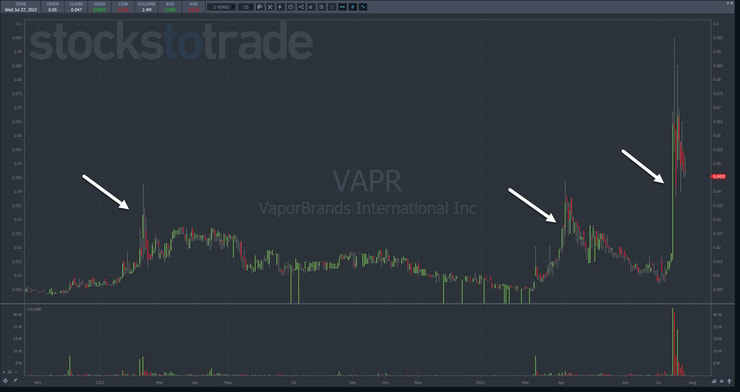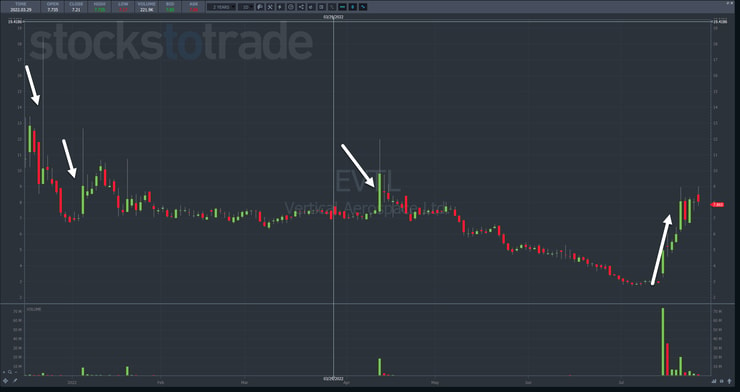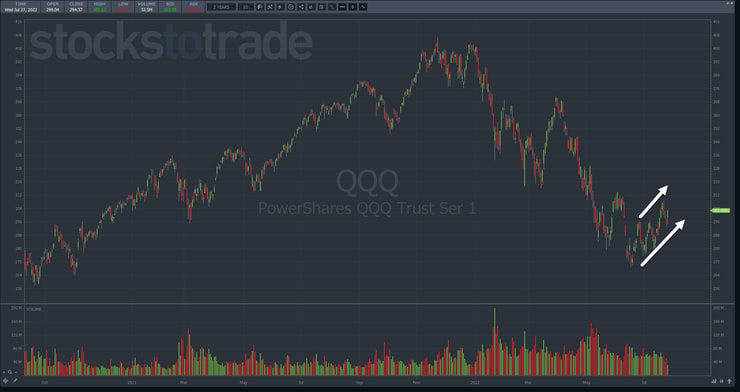99% of the financial world’s only concern is The Fed and interest rates.
Don’t get me wrong, you should care about what they have to say. After all, they’re likely to affect the lives of everyone around you.
However, as a penny stock trader, I care more about the news and the setups right in front of me.
Right now, I’m seeing something VERY INTERESTING bubbling beneath the surface.
I saw it happen in VaporBrands International Inc. (OTC: VAPR) and Vertical Aerospace Ltd. (NYSE: EVTL).
And it could mean we’re in for a period of lucrative setups in the coming months.
I use this indicator not only to tell me when markets are heating up but also when they’re cooling off.
Its simplicity makes it ideal for any active trader who wants to know when to throttle up risk and when to pull back.
Here’s how it works…
Table of Contents
Identify Former Runners
When I evaluate the market, I look at a basket of stocks that were previous runners.
These stocks either followed my Supernova pattern or simply had massive gains in the past.
For example, VAPR showed a multi-week run at the beginning of 2021.
More recently, the stock did the same thing, albeit over a shorter period of time and more violently.
Now, it’s popping off on HEAVY volume.
But that’s only part of the story.
After the initial run on July 15, the company released material news about a partnership with Ford to supply motors to the electric vehicle maker.
This helped keep shares trading at the upper end of their range. If another material news event hits the stock, it could send shares even higher.
Look for Outsized Moves

2025 Millionaire Media, LLCThe first two moves I highlighted in the chart of VAPR look fairly similar. Shares popped on decent volume with a multi-day run preceding the move.
The most recent move is wholly different.
You can see huge volume and a massive run in just one day. While shares briefly pulled back, they were given another boost by the press release.
That’s what I’m seeing right now.
Outsized moves, almost like how a stock makes a bottom.
EVTL is another great example.
Compare the first three spikes to the most recent one.
The recent spike came with heavier volume and remade it a multi-day runner!
That creates a lot of opportunity for dip buying setups.
But these aren’t the only two stocks acting this way.
I’m seeing a host of stocks across the board, from OTC markets to small cap Nasdaq plays, experiencing heavy volume and running for several days.
Earlier this year, most stocks were one-and-done. They would fall apart after the first spike.
Now, this isn’t as bullish as the start of 2021 when we’d see even the worst of the worst stocks soar for days.
More Breaking News
- Intra-Cellular Therapies: Analyzing Market Trends and Predictions
- BXP Inc. Transforms Real Estate Landscape with Strategic Acquisitions: Is a Rebound Imminent?
- Is Palantir Technologies Heading for a Major Shift After Recent Setbacks?
However, it’s a notable difference from the entire first half of 2022.
Place it in Context
I also look at the broader market risk assets to see their performance.
If you look at the Nasdaq 100 index, which got throttled in the first half, it’s turned around nicely the last month or so.
Keep in mind, this is still a bounce in a downtrend.
However, the Nasdaq 100, a basket of riskier assets, has made a series of higher lows and higher highs.
But, if it can get over $312-$315, it has a lot of room to run higher.
And if you look at other risk indexes like the S&P Biotech Index (ARCX: XBI), its relative strength bodes well for many of these Monkeypox and pharma plays.
The Bottom Line

2025 Millionaire Media, LLCAcross the board, interest is growing in small-cap plays.
You need look no further than the increased chatter amongst promoters on social media to see the resurgence.
Heck, I’ve even seen headlines about Wall Street Bets and meme stock hordes pop up.
Now, this doesn’t necessarily mean that this will last for the rest of the year.
It may only give us a few months.
However, I make sure to prepare my students so that they’re all over them when these opportunities present themselves.
—Tim






Leave a reply